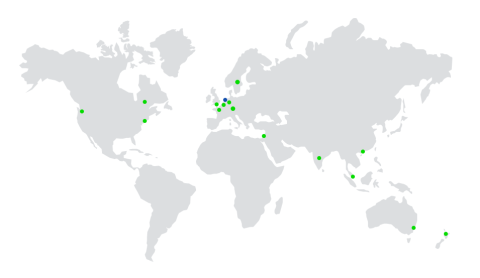
Enterprise Asset Management
Enterprise Asset Management (EAM) is the entire lifecycle management of the physical assets of an organisation such as buildings, installations, infrastructure and real estate assets. EAM covers the design, construction, commissioning, operations, maintenance, replacement and demolishment of all assets, equipment and facilities. "Enterprise" in EAM refers to the scope of assets: all asset types, across all locations, throughout the organisation.
Enterprise Asset Management encompasses all policies, processes, operating models, management, economics, documentation and sustainable aspects that relate to these assets.
Goal of EAM
In facilities and real estate management, EAM includes buildings, infrastructure and technical installations as well as assets such as space, workspaces, fleet, vending machines, meeting rooms, and employee centric assets and facilities. So why is Enterprise Asset Management important? The primary goal of EAM is to optimise the full life cycle of these assets by:
- Standardising, integrating and continuously optimising asset related processes.
- Achieving more flexibility in usage and a more effective utilisation of assets.
- Operating and maintaining assets at lower cost.
- Increasing continuity, reliability and security of assets.
- Complying with health and safety legislation and asset lease accounting regulations.
- Reducing the sustainable impact of assets.
- Replacing non-performing assets.
The benefits of Enterprise Asset Management are clearly recognised, but due to the broad scope of EAM and its interdisciplinary nature, professional Enterprise Asset Management is always supported by EAM software technology.
More than just maintenance
Asset management is often connected to the maintenance processes of assets. In the case of Enterprise Asset Management, the scope of assets includes the real estate portfolio assets and the associated management process. This includes understanding the location of assets within space, who is utilising the assets, and the financial impact. A solution for Enterprise Asset Management is therefore quite complex in nature, which is why EAM software is much more comprehensive than Computerised Maintenance Management Software (CMMS).
Learn more about Enterprise Asset Management

How to get the basics in place for effective asset & maintenance management
This document describes five questions to ask yourself to get the basics for effective maintenance in place, starting with a structured asset repository.
Read more
Planon Asset & Maintenance Management
Planon’s Asset & Maintenance Management solution minimises asset downtime and disruption while managing the entire lifecycle from start of use, to ongoing management, to removal or sale of asset.
Read moreEAM software versus ERP software
Enterprise Resource Planning (ERP) is business management software that allows an organisation to use a system of integrated processes to manage its core business activities. ERP is designed to combine all the company’s activities into a single database, eliminating incompatible and duplicate technologies. ERP is very strong in processes like finance, logistics, and procurement and can do an excellent job of managing an organisation’s core business processes.
At first glance, utilising an ERP system to support Enterprise Asset Managment processes looks very interesting; there is only one software system and data is all in one place. However, for Enterprise Asset Management and business support processes such as corporate real estate management, space management and maintenance planning, these ERP systems can be difficult to use and difficult to implement. Click here for a whitepaper to learn more about ERP in facility and real estate management.
EAM software for real estate assets
Software solutions for Enterprise Asset Management that support the lifecycle of buildings, its infrastructure, and real estate assets, are labelled differently in the industry. Some more commonly used labels are:
- Integrated Workplace Management Systems (IWMS).
- Computerised Maintenance Management Systems (CMMS).
- Real Estate Management Systems (REMS).
- Property Management Systems (PMS).
- Space Management Systems (SMS).
- Computer Aided Facility Management Systems (CAFM).
IWMS is the most similar label to an EAM system and supports the lifecycle of all business support assets including real estate, infrastructure, technical installations, space, workspaces, fleet, vending machines, meeting rooms, and facilities. Click here to learn more about IWMS.
EAM scope of Integrated Workplace Management Systems (IWMS)
IWMS encompasses all the functions and processes that relate to the operational and maintenance phase of any asset including:
- Real estate portfolio planning and management.
- Capital projects and replacements.
- Space planning and management.
- Asset administration and operations management.
- Centralised call logging, processing and monitoring.
- Maintenance planning, financial forecasting and budget control.
- Asset integration for meter readings and just-in-time (JIT) maintenance.
- Mobile field services execution.
- Tracking and reducing sustainability impacts.
- Asset performance reporting and analysis
IWMS typically supports integration with Computer Aided Design (CAD) systems such as AutoCAD, to combine the above database information with graphical asset information and documentation. Innovative IWMS vendors offer integration with Building Information Modelling (BIM) systems such as Revit, to connect seamlessly an asset’s design and construction phase with the operational and maintenance phase. As an IWMS brings all data and processes together in one single source of truth, organisations are able to make better decisions to prolong the lifecycle of their assets, to use resources effectively and reduce overall costs.
Discover Planon Maintenance Management
Our global succes stories

King's College London
Elizabeth Harris, Business Information Systems Manager: 'The solution allowed us to reduce our maintenance backlog by 50% within three months.'
Explore now
Bayer Real Estate
Michael Müller, Managing Director Bayer Real Estate: "Successful RE and FM with Planon."
Explore now
ETH Zürich
Walter Iten, Managing Director of the Real Estate department: "Compliant and in control with Planon software."
Explore now



















